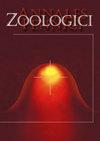Wintering and Stop-Over Areas of Grey Herons (Ardea cinerea) Breeding in Central Europe: A Ring-Recovery Analysis
IF 0.9
4区 生物学
Q4 ECOLOGY
引用次数: 4
Abstract
We analysed migration distances of sub-adult and adult grey herons (Ardea cinerea) ringed in Poland between 1932 and 2014 when migrating to wintering and stop-over areas. The research was based on 239 ring recoveries during non-breeding periods from 92 ringing sites in Poland. We used location of ringing sites, age of bird, and year of recapture to explain variation in the observed distances between breeding and stop-over as well as wintering areas. We found variation in the location of non-breeding areas of grey herons from northern and southern Poland. Migration distance of grey herons increased with latitude, with birds from northern Poland spending the non-breeding period further away than birds from southern Poland. Considering possible shortening of the migration distance due to climate change, we analysed frequency of recoveries from the vicinity of the breeding site, Mediterranean and sub-Saharan zones. Despite reported claims of climate change leading to migration distance becoming shorter, we found that distance to those areas was not affected significantly by year. In contrast to previous studies made in western Europe, age of bird did not affect migration distance.中欧灰苍鹭(Ardea cinerea)繁殖的越冬和停留区:环恢复分析
我们分析了1932年至2014年间在波兰环绕的亚成年和成年灰鹭(灰鹭)迁徙到越冬和中途停留地区的迁徙距离。这项研究基于波兰92个振铃点在非繁殖期的239个振铃回收率。我们使用振铃地点的位置、鸟的年龄和重新捕获的年份来解释繁殖和中途停留以及越冬区域之间观察到的距离的变化。我们发现波兰北部和南部灰鹭非繁殖区的位置存在差异。灰鹭的迁徙距离随着纬度的增加而增加,来自波兰北部的鸟类在非繁殖期比来自波兰南部的鸟类走得更远。考虑到气候变化可能缩短迁徙距离,我们分析了繁殖地附近、地中海和撒哈拉以南地区的恢复频率。尽管有报道称气候变化导致迁徙距离缩短,但我们发现,到这些地区的距离并没有受到明显的影响。和之前在西欧进行的研究相反,鸟类的年龄并没有影响迁徙距离。
本文章由计算机程序翻译,如有差异,请以英文原文为准。
求助全文
约1分钟内获得全文
求助全文
来源期刊

Annales Zoologici Fennici
生物-动物学
CiteScore
2.40
自引率
14.30%
发文量
10
审稿时长
>12 weeks
期刊介绍:
Annales Zoologici Fennici publishes mainly original research reports, but also in-depth reviews and commentaries on all aspects of animal ecology and evolution, and fields related to them. Our aim is to promote papers which focus on the interactions among various components in the past and present environments by using integrative and cross-disciplinary approaches. This may be achieved by employing tools from different fields of research, such as (but not restricted to):
ecology and paleoecology,
molecular ecology and phylogeography,
conservation biology, human-induced contemporary evolution and wildlife management,
animal behaviour and interactions (including recognition systems and mechanisms),
paleontology (except systematics and taxonomy) and evolution,
bioenergetics.
 求助内容:
求助内容: 应助结果提醒方式:
应助结果提醒方式:


